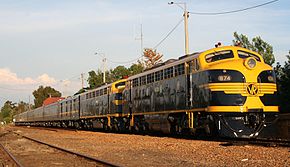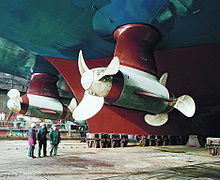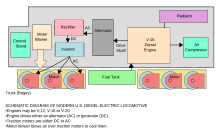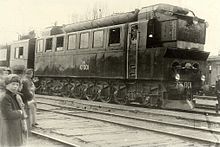Diesel-electric drive

The diesel-electric drive is a transmission system with which the mechanical energy generated by large diesel engines is converted into electrical energy with the help of a generator and transferred to the drive system of a machine. The most common applications are diesel-electric locomotives , submarines and ships as well as large trucks for opencast mines ( large dump trucks ).
principle
Strictly speaking, diesel-electric drives are electric drives that have their own power plant in the form of a generator driven by a diesel engine . The generated electrical energy is used to supply electric motors that drive the wheels or propellers directly or via a transmission gear.
Like all internal combustion engines, diesel engines can only be operated with good efficiency in a narrowly limited load range and cannot be started up under load. In the case of smaller drive units (for example in motor vehicles ), these weaknesses are circumvented with a gearbox and a mechanical clutch ; this is known as a diesel-mechanical drive . For greater performance requirements, such as locomotives or ships, either the diesel-hydraulic or the diesel-electric drive is used.
The diesel-electric drive has the advantage over the diesel-hydraulic drive that it is relatively simple and less prone to failure. In addition, due to the very small number of units, there are hardly any hydraulic drive elements available in suitable sizes. The electronic control of the power transmission enables good performance adjustments and driving comfort in a wide range.
The diesel-electric drive can be combined to form a hybrid drive that enables driving even without the diesel engine running, as the electric traction motors draw their energy on certain routes either from accumulators or - in the case of rail vehicles - from an overhead line . (The UN definition does not, however, include the contact line variant among the hybrid drives). According to the logic that hybrid equals two energy sources, the pure diesel-electric variant is not counted among the hybrid drives, but the combination with accumulator is.
Development history

The first ship built with a diesel engine in 1903, the tanker Vandal , was equipped with a diesel-electric drive because its diesel engine could not yet be reversed like a steam engine.
The forerunner of the diesel-electric drive in locomotives is the steam-electric drive by Jean-Jacques Heilmann . In 1892 he presented the "Fusée Electrique" (electric rocket), an electric locomotive that obtained its electricity from a generator that was powered by a steam engine in the vehicle. In doing so, he had developed the first rail-mounted electric motor vehicle that could operate independently without an external power supply. Also around the First World War, some light rail locomotives were electrically powered by benzene .
The M 290 "Slovenská Strela" (German: Slovak arrow) ( ČSD M 290.001 and 002 ) of the Czechoslovak State Railways , which went into operation in 1936, have a variable mechanical-electrical drive. They were powered by two gasoline engines. The originally intended diesel drive was abandoned during testing because the engines were too loud. Each motor is connected to the "rotating stator" (external rotor) of a generator, the rotor (internal rotor) works together with an electric motor via a gearbox on an axle. At standstill and at low speeds, the speed difference in the generator and thus the power generated is high and the power is transmitted entirely or predominantly electrically. With increasing driving speed, the speed of the generator internal rotor and thus the proportion of the mechanically transmitted power increases and the proportion of the power electrically transmitted via the electric motor decreases. From 85 km / h the generator is bridged by a clutch and the power is only transmitted mechanically. The drive can be controlled by throttling the gasoline engine and changing the excitation current in the generator and electric motor.
With the advent of usable diesel engines for vehicles, the older concept of gasoline-electric drive with gasoline engines was adapted for the new diesel engines. The Э эл 2 (E el 2) of the Soviet Railways (SŽD), designed by Yuri Vladimirovich Lomonossow , was the first diesel-electric mainline locomotive.
With the emergence of new and larger power semiconductors around the year 2000, the use of three-phase generators with three-phase asynchronous motors , together with electronic power control using power transistors (IGBT) or GTO thyristors , in which the frequency and voltage of the current are controlled by frequency converters is adapted to the respective driving situation.
Rail transport
The diesel-electric drive predominates in mainline locomotives worldwide. As early as 1958, British Rail (ways) put the new multi-purpose locomotives Type 4 (designation from 1973: Class 40 ) from English Electric into service. The NoHAB AA16 and their licensed NMBS / SNCB series 202 from Anglo-Franco-Belge (AFB) were widespread in Europe . The SNCF also used this type of drive in France . Only at the Deutsche Bundesbahn (DB) and initially the Deutsche Reichsbahn (DR) were decisions made in favor of the diesel-hydraulic drive in the 1950s . When it was founded in 1994, Deutsche Bahn AG only took over diesel-electric mainline locomotives from the DR fleet ( classes 232-234 and 241 ). In the meantime, Deutsche Bahn is also purchasing diesel-electric locomotives. The 37 machines in the 245 series are even equipped with four diesel generator units.
In diesel-electric multiple units, electric traction motors can be located in different cars than the diesel generator. In the British Class 220 intercity trains , diesel generators and traction motors are distributed throughout the train. Each car has a 560 kW diesel engine, which by means of a generator supplies the electricity for an electric drive motor. The latter drives one of the four axles of the car.
The Rotterdam tram built its M 17 multiple unit for its overland routes from 1961 to 1963 from two used electric tram cars with a former diesel multiple unit as a generator car in the middle. In the rack railway Diakopto-Kalavryta in Greece a generator car between the two was in the same building principle railcars . The route did not allow larger axle loads, which is why the electrical "power station" was housed in a separate car.
Cogwheel train with generator wagons of the Diakopto – Kalavryta Railway
245 012 of Deutsche Bahn in Munich
Omnibuses
- The London bus company Thomas Tilling put hundreds of Tilling-Stevens Petrol-Electric buses ( double-decker and monoplane) into operation in several series from 1911 to 1925 , which combined an internal combustion engine with an electric drive. Since the diesel engine was not yet fully developed, a gasoline engine was used. The last buses were taken out of service in 1933.
- In the 1930s there were hundreds of diesel-electric city buses in numerous cities across the United States . For example, in Newark there were both over 500 diesel-electric buses and over 500 trolleybuses , which also had a diesel engine so that they could drive in the city center independently of the overhead line (so-called "all-service" buses). These duo buses ran until 1948, the simple diesel-electric buses were in operation until the end of 1955.
- From 1946 to 1950 a diesel-electric city bus was produced in the Soviet Union under the designation ZIS-154 in an edition of 1165 copies.
- In 1964 the prototype of a regular service bus was designed and built in Charleroi (Belgium), the diesel engine of which was directly connected to a three-phase generator at the rear and which was equipped with two DC motors as wheel hub drives on the rear axle . This enabled the floor height of 600 mm, which was low for the time, to be achieved.
- For a number of years, Daimler-Benz offered the Midibus Cito (O 520) , which had a diesel-electric drive. This model is no longer offered.
- New Bus for London
Special vehicles
As early as 1956, the Chelyabinsky Traktorny Sawod began planning a diesel-electric bulldozer. The DET-250 , which weighs around 32 tons , has been in series production since 1961.
The dumper 'Liebherr T 282 B' is used in ore mines according to the company's largest land vehicle with a diesel-electric drive. Special features: For reasons of reliability and lower maintenance costs , the vehicle does not have a conventional service brake , but brakes mainly via the two electric drive motors, one of which is attached to the rear axle directly behind each wheel hub . With this arrangement, a differential gear can also be dispensed with, since the speed of each wheel can be regulated separately. The power of the electric motors is designed for the necessary braking power when fully loaded and is approximately twice as high as that of the driving, 2700 kW diesel engine. The electrical energy gained during the braking process is converted into heat via braking resistors .
Ships


- Wuppertal (1936), the world's first large cargo ship with diesel-electric propulsion
- Huascaran and Osorno (both 1938), combi freighter the HAPAG
- Patria (1938), HAPAG passenger ship
- Kormoran (1938) as a Styria HAPAG cargo ship, from 1940 trading sturgeon cruiser of the Navy
- Robert Ley (1939), cruise ship of the Nazi organization German Labor Front
- Queen Elizabeth 2 (1969), Cunard Line passenger ship, originally a turbine ship , converted to diesel-electric propulsion in 1986
- Queen Mary 2 (2004), transatlantic liner from Carnival Corporation & plc
- Concordia class (2006–2012), five cruise ships from Carnival Corporation & plc
- MSC Splendida (2009), MSC Cruises cruise ship
- Enok (1955), motor ship , converted to diesel-electric drive in 2010
- MSC Meraviglia (2017), cruise ship of MSC Cruises
- Sea-Watch 4 (1976), rescue ship, formerly German research vessel "Poseidon"
Cargo ship Enok , engine room with encapsulated diesel generators and electric traction motors
Queen Elizabeth 2 in 1993 in Southampton
Web links
Individual evidence
- ^ Fund Jean-Jacques Heilmann, ingénieur-électricien (1853–1922) at archivesnationales.culture.gouv.fr, accessed on March 8, 2019
- ↑ http://www.parostroj.net/vozidla/M290/M290.htm Article about the M 290 (Czech)
- ↑ With four motors in: Lok Magazin 7/2014, p. 32 ff.
- ^ Howard Johnston, Ken Harris: Train Recognition Guide . Harper Collins, London 2005, ISBN 0-00-718226-0 , pp. 395 .
- ↑ Louis Clessens: The “Electrobus” - a renaissance of the diesel-electric bus? In: Der Stadtverkehr , Heft 4/1965, p. 122, Verlag Werner Stock, Brackwede 1965
- ↑ Louis Clessens: The “Electrobus” - a renaissance of the diesel-electric bus? In: Der Stadtverkehr , Heft 4/1965, p. 122/123, Verlag Werner Stock, Brackwede 1965
- ↑ Presentation of the Enok on the drive manufacturer's website ( memento of the original from January 13, 2013 in the Internet Archive ) Info: The archive link was automatically inserted and not yet checked. Please check the original and archive link according to the instructions and then remove this notice.











